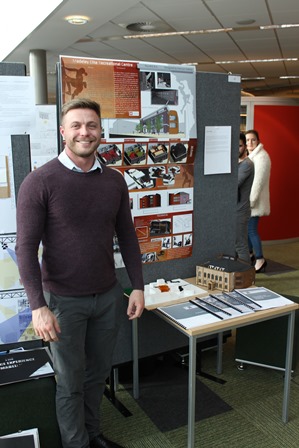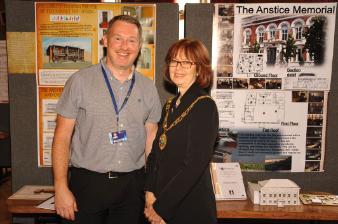
Architecture students bring historical building back to the future
University of Wolverhampton architecture students have designs on bringing a historical building back to the future in Telford.
The Anstice Memorial Hall, which is located in Anstice Square in Madeley, is almost 150 years old and was opened as a working men’s club in 1870 in memory of local businessman, John Anstice, a founder of the Madeley Wood Company.
After closing its doors in 2014, a local campaign resulted in Madeley Town Council (MTC) buying the building with potential uses being considered following community surveys and engagement.
Teaming up with Madeley Town Council, students in their final year of studying for Interior Architecture and Property Development and Architectural Design Technology worked on a real life client project for their Major Project Design and Exhibition Module as part of their degree. Throughout the project, the client engaged with students both during the initial feedback sessions and when students presented their final design work.

Following a site visit to determine the size of the project and to look at the surrounding area, the building was scanned with a 3D laser to capture technical details. The resulting point cloud data was used by Building Modelling Technologies students to develop a 3D Revit model of the building which was then used to create final project designs.
Paul Boden, Technical Resource Manager from the School of Architecture and Built Environment at the University, said: “Not only does the building have architectural significance, it also has local historical importance. It is Grade II listed and retains much of its original configuration, especially the front façade and the upstairs ballroom, playing an important role as a focal point for social and cultural activities in Madeley.
“Students collaborated on this real life project to create scale models using a combination of traditional model making techniques, 2D laser cutting and etching and 3D printing. They also produced project display presentation boards to present to council members, which was great hands-on experience for them.”
Samson Oakley, Architectural Design Student, said: “Working on the Anstice as part of a live project was not only educational, but also enjoyable. Working with new technologies that enhance both the visual and accurately measured aspect of an existing building gave me a lot of insight into designing and surveying of a site. The project gave me a passion for Building Information Modelling (BIM) which is where I see my qualification taking me.

“The start of the process involved laser scanning the building both internally and externally. This gave us a digital representation of the building which could then be recreated using a 3d modelling software called REVIT. Myself and the other students got to experience how a project like this is done on a professional level, which I believe has given me a lot of insight into the architectural and construction industry. The project gave us a clear understanding of the importance of communication on all levels of a project, and how working using modern technologies can aide in adapting such an old building.”
The students hosted an End of Year Exhibition to showcase their work and the final display held recently in the Anstice Building ballroom during the Madeley Victorian Fete resulted in positive feedback from the local community.

The student work has been shown at several external outreach events including the Madeley Town Council Annual Parish meeting and the Chartered Institute of Architectural Technologists (CIAT) Inaugural aspirATions West Midlands event.
Kath Petty, Town Clerk for Madeley Town Council, said: “We have found working with the University of Wolverhampton on the Anstice project to be a very positive and productive experience.
“We were impressed with the response of the students and their enthusiasm, which was encouraged and guided by their course tutors. The final pieces of work demonstrated that the students had taken on the brief, found imaginative solutions and presented them in a very professional manner.”
Andy Rose, Regeneration Officer at Madeley Town Council, said: “I have been very pleased with the new working partnership that has been developed with the Department of Architecture & Design at the University of Wolverhampton.
“The intention was to make the experience for students as genuine as possible working on a “real” project that was being developed in parallel by our private consultants. I was impressed with the enthusiasm and commitment shown by the students and lecturers from the inception meeting through to the final presentation of their proposals.
“It was great to give students a free rein to explore new ideas and techniques whilst at the same time keeping true to the original form of the Grade II listed building. I am sure that when local people and councillors see some of the ideas that have been developed it will give them much more to think about as the project evolves.”
Find out more about the School of Architecture and Built Environment and watch the students at work: https://www.youtube.com/watch?v=adVaB5j_CIQ.
For more information about the Anstice project follow progress on Twitter @save_anstice and Facebook: https://www.facebook.com/groups/1399708466950926/.
ENDS
For more information please contact the Media Relations Office on 01902 322736, 01902 322003 or 01902 518647.
Date Issued: 1st September 2016
For more information please contact the Corporate Communications Team.


/prod01/wlvacuk/media/departments/digital-content-and-communications/images-2024/240328-Varsity-Line-Up-Resized.jpg)
/prod01/wlvacuk/media/departments/digital-content-and-communications/images-18-19/220325-Engineers_teach_thumbail.jpg)
/prod01/wlvacuk/media/departments/digital-content-and-communications/images-2024/240423-Additive-Research-Centre-Launched.jpg)
/prod01/wlvacuk/media/departments/digital-content-and-communications/images-2024/240320-Uzbekistan-Resized.jpg)
/prod01/wlvacuk/media/departments/digital-content-and-communications/images-2024/240229-The-Link-Resized.jpg)
/prod01/wlvacuk/media/departments/digital-content-and-communications/images-2024/240416-Abi-Dare-Resized.jpg)

